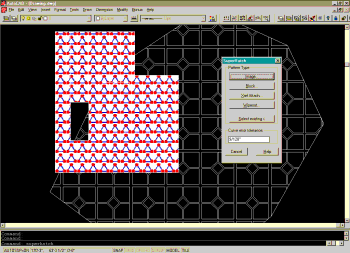
Autodesk's New
Express Tools for AutoCAD R14
Comments by: Odin
Cary
We have all come to know them as "The Bonus Tools", those great new routines that were shipped with R14 as a bonus. Unfortunately for many, these tools were not installed or simply not loaded and thus they may still be unaware of one of the best parts about AutoCAD R14. If you are one of these people, see Missing Bonus on the Tips + Tricks menu.
"Express Tools" is the name for the expanded set of Bonus Tools; a set previously only available to Autodesk's VIP subscribers. You may now purchase groups of these new tools for use with AutoCAD R14 -> ExpressTools .
There are quite a few new tools and I suspect the list is still growing. I am only going to provide an evaluation of the one new tool that got me most excited: SuperHatch. As for the rest of the tools, I suspect that if you find any of the Bonus Tools you got with AutoCAD R14 valuable you will surely find the new tools equally beneficial (there are also improvements to the original tools).
SuperHatch
(V.1)
As a person who has drawn countless buildings in
AutoCAD, the very thought of creating personalized, on-the-fly,
hatch patterns evokes euphoria.
When I pulled up the command, I did not expect to see so many options, like Image..., Block..., Xref Attach..., Wipeout... and Select existing<. What I did expect, was to be allowed to select anything I had drawn on the screen and consequently fill a closed perimeter with that selection. Well, sort of...
To fill or "hatch" a closed perimeter, you basically have to use a block of what you want to hatch with. That part is easy; draw your pattern and then block it. When you SuperHatch with that block, you have to place its origin (a great feature), you have to designate the amount of space it defines (to allow for space around the pattern, like tiles for example) and you have the basic Bhatch options like Pick a point and Island detection. It is really rather easy to understand and use.
Editing is where
the problems arise. SuperHatch is not a Fill; it is not like
Bhatch in that you can modify it simply by stretching the
perimeter. SuperHatch basically arrays your selection within a
closed perimeter. It keeps the array together by using the Group
command in AutoCAD. The good part about this is that you can make
unique changes to a part of your pattern. The bad part about this
is that it is very much like the old AutoCAD hatch command from
release 12 back; where we basically just erased the pattern and
re-hatched every time a change was made that affected the
appearance of the pattern. 
In the example to the right, I demonstrate two types of patterns: a block pattern and an image pattern. I will certainly use the block pattern a great deal. In architecture, it is ideally suited for floor tiles which have never been provided in the Bhatch pattern list.
The other pattern (colored) shows that one could also just use a bitmap to cover an area. When you use an image, the image is actually managed by the Image command (an Xref-like control for images). This means that substitutions are possible as well as the Unload or Detach options.